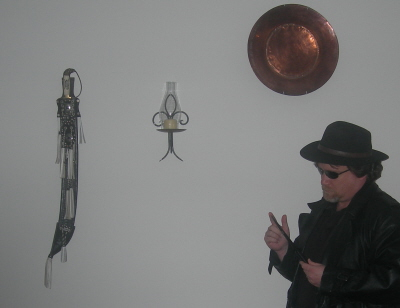|
About This Author
Come closer.
|
Complex Numbers #1084077 added February 19, 2025 at 8:31am
Restrictions: None
Fail to Succeed
Another one from Mental Floss today, because my random number generator likes to mess with me.
But first, a quick announcement and stealth plug:
Starting tomorrow, and running through March 20, Elisa, Stik of Clubs  is hosting another round of "Journalistic Intentions" is hosting another round of "Journalistic Intentions"  [18+]. I intend to participate. I'd like some competition, so if you have a blog or are thinking of starting one (and you should, because I've heard a rumor that a blogging/commenting streak Achievement badge is in the works and no, that's not a secret), check it out. I only have a few meager entries left in this one, and my intention is to devote eight of them to that activity. [18+]. I intend to participate. I'd like some competition, so if you have a blog or are thinking of starting one (and you should, because I've heard a rumor that a blogging/commenting streak Achievement badge is in the works and no, that's not a secret), check it out. I only have a few meager entries left in this one, and my intention is to devote eight of them to that activity.
But for today, on to the article:
To be clear, sometimes—perhaps even often—experiments fail. If they didn't, they wouldn't be experiments. But sometimes, they fail so completely that it makes you wonder whether the cliché should be "curiosity killed the human."
I should initiate the Hughes Award for such experiments. "Mad" Mike Hughes was a flat-Earther who designed and built a steam-powered rocket to prove to himself that our planet is flat. I've written about him before. The rocket, somewhat predictably, exploded with him inside (and even if it hadn't, it wasn't designed to get high enough to rule out the reality that the Earth is roughly spherical). You might say, "Well, there's already the Darwin Awards to cover that sort of thing," but the Darwin Awards only consider a subset of Stupid Human Tricks.
Not all of the featured failures are quite that spectacular or, some might say, tragic. Out of the 14 in the article, I'll just highlight a few here.
1. Winthrop Kellogg's Ape Experiment
In the early 1930s, comparative psychologist Winthrop Kellogg and his wife welcomed a healthy baby boy they named Donald.
No, not that Donald. Or that one, either. Also, not that Kellogg.
The psychologist had grown interested in those stories of children who were raised feral—but he didn’t send Donald to be raised by wolves. He did the opposite: He managed to get his hands on a similar-aged baby chimp named Gua and raised her alongside Donald.
On the surface, considering the state of knowledge in the 1930s (DNA hadn't been invented yet, for example, but it was known that humans and chimpanzees were closely related on an evolutionary scale), this was a perfectly reasonable experiment—provided one ignores the ethical considerations involved in, for starters, separating a baby chimp from her tribe.
As the article notes, the experiment didn't quite pan out (that's a pun, and it's very much intentional).
2. The Stanford Prison Experiment
You may have heard about the Stanford Prison Experiment, a social psychology study gone awry in 1971. The point of the experiment, which was funded by the U.S. Office of Naval Research, was to measure the effect of role-playing and social expectations. Lead researcher Philip Zimbardo had predicted that situations and circumstances dictate how a person acts, not their personalities.
I can't help but note the similarities between this one and the chimp one, because both were about innate traits vs. environmental conditioning.
Most people have heard of this one, but there's a lot of misinformation about it out there, and I suspect that it functions as kind of a test of a person's preconceived notions, much as the novel Lord of the Flies does. If you haven't heard about it, the article goes into more detail—but I wouldn't fully trust Mental Floss to get it right.
3. Franz Reichelt's Aviator Suit
Now, this one would be a retroactive candidate for the Hughes Award.
In the early 1900s, Reichelt crafted a parachute from 320 square feet of fabric, all of which folded up into a wearable aviator suit. He had conducted several parachute tests using dummies, which all failed. He pinned the blame on the buildings, saying that they simply weren’t tall enough.
I think we can all see where this is going, but, again, our state of knowledge in the early 1900s was even more incomplete than it is now. Hell, the first powered flight was late 1903.
In 1912, Reichelt planned to test his latest version by flinging a dummy from the Eiffel Tower. But when he arrived at the famous landmark, the inventor surprised the waiting crowd by strapping on the parachute suit himself and taking the leap.
Hence, the Hughes Award.
The parachute didn’t open, however, and Reichelt became a victim of his own invention. (An autopsy reportedly determined that he died of a heart attack on the way down.)
So, the next time someone tells you "It's not the fall that kills you; it's the sudden stop at the end," remember Monsieur Reichelt and how the fall actually did kill him.
But mostly I'm including this one in my commentary to note that, from then on, the famous Paris landmark would be known as the I-Fell Tower.
5. William Perkin's Mauve-lous Mistake
He had unwittingly discovered a way to produce mauve. The color was a smash hit, especially after Queen Victoria donned it for her daughter’s 1858 wedding.
I'm leaving this one here to illustrate that sometimes failures are actually successes in disguise. Not the parachute guy, obviously, though we learned from that, too.
7. The Cleveland Indians' 10-Cent Beer Night
In 1974, the Cleveland Indians tinkered with a new promotion to increase game attendance—giving fans the opportunity to purchase an unlimited amount of beer for 10 cents a cup, which wasn't the best idea.
Since the article won't do it, I will: 10 cents in 1974 is roughly equivalent to 65 cents in early 2025.
Which is about 1/10th of what they sometimes charge for good beer at a drafthouse, but I have no idea what they charge for watered-down swill "beer" at a ball game.
At any rate, I think it's pretty obvious why selling cheap beer in a stadium full of already hyped-up sports fans is a Bad Idea.
10. The New Ball
The basketball has been tweaked here and there over the years, but the modifications apparently went too far when the NBA experimented with a microfiber ball in 2006. “The New Ball,” as it was commonly known, was cheaper to make and was supposed to have the feel of a broken-in basketball right from the start.
You know, I don't see why this even belongs on the list. Sure, it was an experiment of sorts. Sure, it failed. But no one died or even got seriously injured (the article notes cuts on some players' hands, but that's about it), and then they reverted back to the old basketball.
Feeling deflated, the NBA officially announced they were pulling the ball from play on December 11, 2006—less than three months after its debut in a game.
So I'm mostly including this one to show that I'm not the only one who makes terrible puns.
12. Wilhelm Reich's Cloudbusters
Psychoanalyst Wilhelm Reich managed to draw a straight line from human orgasms to the weather to alien invasion. Influenced by Sigmund Freud’s work on the human libido, Reich extended the concept to propose a kind of widespread energy he called orgone. To give you an idea of how scientifically sound Reich’s concept was, orgone has been compared to the Force in Star Wars.
And this one was less a failure of experiment than it was a failure of theory and critical thinking.
14. New Coke
April 23, 1985, was a day that will live in marketing infamy. And that’s how Coke describes the failed experiment that was New Coke. On that day, the Coca-Cola Company debuted a new version of their popular soft drink made from a new and supposedly improved formula.
Ah, yes: the Great Coke Crisis of 1985, the year I switched to Dr. Pepper (because Pepsi tastes like ass, and RC Cola isn't as widely available as the Big Two colas) and didn't switch back again until around the turn of the century.
The message was received loud and clear. Coke announced the return of Old Coke in July, dubbing it Coca-Cola Classic—and they never experimented with the formula again.
And that's not completely true. They switched from sugar to HFCS, which some say is the exact same thing and others disagree, but regardless, it's a change in formula. I also think Diet Coke benefited from whatever they learned doing New Coke. Most importantly, though, they did muck about with the formula after that, but this time were smart enough to sell it separately instead of replacing the Real Thing. This eventually led to the development of Coke Zero, which is the greatest invention since the Skip Intro button.
Like I said, experiments often fail. If we're smart, we don't die of a heart attack in the process, and can actually learn and grow from the failures. Some of us even have the capacity to learn from the failures of others, though I think "jumping off the I-Fell tower using unproven and questionable gear" isn't something most of us have to be warned against. |
© Copyright 2025 Robert Waltz (UN: cathartes02 at Writing.Com). All rights reserved.
Robert Waltz has granted InkSpot.Com, its affiliates and its syndicates non-exclusive rights to display this work. |

